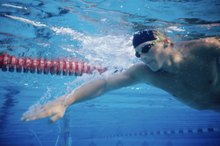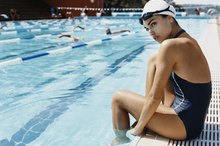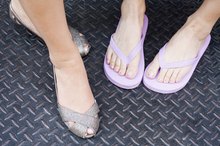What does fact checked mean?
At Healthfully, we strive to deliver objective content that is accurate and up-to-date. Our team periodically reviews articles in order to ensure content quality. The sources cited below consist of evidence from peer-reviewed journals, prominent medical organizations, academic associations, and government data.
- “Journal of Athletic Training”; Superior Labral Lesions: Diagnosis and Management; Donald F. D'Alessandro, M.D., et al.; 2000
- “Journal of Athletic Training”; Superior Labral Lesions: Diagnosis and Management; Donald F. D'Alessandro, M.D., et al.; 2000
- “North American Journal of Sports Physical Therapy”; Prevention and Treatment of Swimmers Shoulder; Brian J. Tovin, D.P.T.; November 2006
- “North American Journal of Sports Physical Therapy”; Prevention and Treatment of Swimmers Shoulder; Brian J. Tovin, D.P.T.; November 2006
The information contained on this site is for informational purposes only, and should not be used as a substitute for the advice of a professional health care provider. Please check with the appropriate physician regarding health questions and concerns. Although we strive to deliver accurate and up-to-date information, no guarantee to that effect is made.
Shoulder Popping While Rotating During Swimming
Swimming may cause shoulder injuries because of the repetitive shoulder movements like rotation. Injuries include tendonitis, impingement syndrome and labral tears. A popping sound or sensation may occur with any of these injuries. Treatment includes rest, ice and non-steroidal anti-inflammatory drugs or NSAIDS. If your symptoms worsen or persist, consult your physician.
If you are experiencing serious medical symptoms, seek emergency treatment immediately.
Causes and Risk Factors
According to a 2006 “North American Journal of Sports Physical Therapy” article, swimmers tend to have excessive external rotation of the shoulder and decreased internal rotation, causing increased stress on rotator cuff muscles and tendons 3. Abnormal shoulder range of motion, tight muscles, overtraining, poor posture and improper swimming technique increase your risk of shoulder injuries and popping. Shoulder injuries include impingement syndrome, tendonitis, bursitis and labral tears. Impingement syndrome is when your rotator cuff tendon and bursa or sac of fluid are compressed and inflamed. Swelling or inflammation can cause cracking or popping of your shoulder during swimming. A labral tear is a tear to the cartilage around your shoulder joint. The torn cartilage may catch during shoulder rotation, causing popping or clicking.
- According to a 2006 “North American Journal of Sports Physical Therapy” article, swimmers tend to have excessive external rotation of the shoulder and decreased internal rotation, causing increased stress on rotator cuff muscles and tendons 3.
- Impingement syndrome is when your rotator cuff tendon and bursa or sac of fluid are compressed and inflamed.
Additional Signs and Symptoms
Tingly Feeling When Doing Pull-Ups
Learn More
Symptoms vary depending on the severity of your injury. You may experience shoulder pain, which may worsen with overhead shoulder movements and swimming. You may also experience shoulder pain while sleeping. Pain may be described as dull, achy, sharp or stabbing. Signs of a shoulder injury include decreased range of motion, point tenderness over your injury and muscle weakness. Muscle atrophy or muscle loss, constant pain and decreased athletic performance are additional signs and symptoms.
- Symptoms vary depending on the severity of your injury.
- You may experience shoulder pain, which may worsen with overhead shoulder movements and swimming.
Treatment
Initial treatment includes rest, ice and NSAIDS such as ibuprofen. While your shoulder is healing, you may need to modify your activities -- avoiding activities that aggravate your symptoms such as swimming, overhead movements and lifting heavy objects. For persistent pain, your physician may recommend physical therapy, corticosteroid injection or surgery. Physical therapy helps you regain normal shoulder range of motion and strength, whereas surgery removes any loose pieces of cartilage and repairs any damage to your cartilage or tendons.
- Initial treatment includes rest, ice and NSAIDS such as ibuprofen.
- While your shoulder is healing, you may need to modify your activities -- avoiding activities that aggravate your symptoms such as swimming, overhead movements and lifting heavy objects.
Prevention
Shoulder Pain After a Workout
Learn More
Cross-train one to two days a week and rest at least one day a week to help prevent overtraining. Include stretching and strength training in your workout routine to increase muscle flexibility and strength. For example, perform shoulder extension, and internal and external rotation using a resistance band to strengthen your rotator cuff muscles. Perform shoulder stabilization exercises to maintain good shoulder stability and reduce your risk of injury. Stabilization exercises include holding a pushup position on the floor or wobble board and step-overs, which are performed walking your hands over a step. Lastly, improve your upright posture and correct any improper swimming techniques. For example, do not let your hand cross the mid-line when you pull your arm back in freestyle swimming.
- Cross-train one to two days a week and rest at least one day a week to help prevent overtraining.
- Include stretching and strength training in your workout routine to increase muscle flexibility and strength.
Related Articles
References
- “American Family Physician”; The Painful Shoulder: Part II Acute and Chronic Disorders; Thomas W. Woodward, M.D., at al.; June 2000
- “Journal of Athletic Training”; Superior Labral Lesions: Diagnosis and Management; Donald F. D'Alessandro, M.D., et al.; 2000
- “North American Journal of Sports Physical Therapy”; Prevention and Treatment of Swimmers Shoulder; Brian J. Tovin, D.P.T.; November 2006
- Kadi R, Milants A, Shahabpour M. Shoulder Anatomy and Normal Variants. J Belg Soc Radiol. 2017;101(Suppl 2):3. doi:10.5334/jbr-btr.1467
- Murphy RJ, Carr AJ. Shoulder pain. BMJ Clin Evid. 2010;2010:1107.
- Singh B, Bakti N, Gulihar A. Current Concepts in the Diagnosis and Treatment of Shoulder Impingement. Indian J Orthop. 2017;51(5):516-523. doi:10.4103/ortho.IJOrtho_187_17
- Minns lowe CJ, Moser J, Barker K. Living with a symptomatic rotator cuff tear 'bad days, bad nights': a qualitative study. BMC Musculoskelet Disord. 2014;15:228. doi:10.1186/1471-2474-15-228
- Cleveland Clinic. Frozen Shoulder. 2019.
- De carli A, Pulcinelli F, Rose GD, Pitino D, Ferretti A. Calcific tendinitis of the shoulder. Joints. 2014;2(3):130-6.
- Raney EB, Thankam FG, Dilisio MF, Agrawal DK. Pain and the pathogenesis of biceps tendinopathy. Am J Transl Res. 2017;9(6):2668-2683.
- Alentorn-geli E, Assenmacher AT, Sánchez-sotelo J. Distal biceps tendon injuries: A clinically relevant current concepts review. EFORT Open Rev. 2016;1(9):316-324. doi:10.1302/2058-5241.1.000053
- Wilk KE, Macrina LC, Cain EL, Dugas JR, Andrews JR. The recognition and treatment of superior labral (slap) lesions in the overhead athlete. Int J Sports Phys Ther. 2013;8(5):579-600.
- Chillemi C, Franceschini V. Shoulder osteoarthritis. Arthritis. 2013;2013:370231. doi:10.1155/2013/370231
- Warth RJ, Martetschläger F, Gaskill TR, Millett PJ. Acromioclavicular joint separations. Curr Rev Musculoskelet Med. 2013;6(1):71-8. doi:10.1007/s12178-012-9144-9
- Defroda SF, Nacca C, Waryasz GR, Owens BD. Diagnosis and Management of Distal Clavicle Osteolysis. Orthopedics. 2017;40(2):119-124. doi:10.3928/01477447-20161128-03
- Dumont GD, Russell RD, Robertson WJ. Anterior shoulder instability: a review of pathoanatomy, diagnosis and treatment. Curr Rev Musculoskelet Med. 2011;4(4):200-7. doi:10.1007/s12178-011-9092-9
- Chalidis B, Sachinis N, Dimitriou C, Papadopoulos P, Samoladas E, Pournaras J. Has the management of shoulder dislocation changed over time? Int Orthop. 2007;31(3):385-9. doi:10.1007/s00264-006-0183-y
- Armstrong A. Diagnosis and clinical assessment of a stiff shoulder. Shoulder Elbow. 2015;7(2):128-34. doi:10.1177/1758573215569340
- Dee SW, Kao MJ, Hong CZ, Chou LW, Lew HL. Chronic shoulder pain referred from thymic carcinoma: a case report and review of literature. Neuropsychiatr Dis Treat. 2012;8:399-403. doi:10.2147/NDT.S36476
- Park SI, Choi YK, Lee JH, Kim YM. Effects of shoulder stabilization exercise on pain and functional recovery of shoulder impingement syndrome patients. J Phys Ther Sci. 2013;25(11):1359-62. doi:10.1589/jpts.25.1359
- Block JE. Cold and compression in the management of musculoskeletal injuries and orthopedic operative procedures: a narrative review. Open Access J Sports Med. 2010;1:105-13.
- Shih YF, Liao PW, Lee CS. The immediate effect of muscle release intervention on muscle activity and shoulder kinematics in patients with frozen shoulder: a cross-sectional, exploratory study. BMC Musculoskelet Disord. 2017;18(1):499. doi:10.1186/s12891-017-1867-8
- Razmjou H, Robarts S, Kennedy D, Mcknight C, Macleod AM, Holtby R. Evaluation of an advanced-practice physical therapist in a specialty shoulder clinic: diagnostic agreement and effect on wait times. Physiother Can. 2013;65(1):46-55. doi:10.3138/ptc.2011-56
- Sun Y, Chen J, Li H, Jiang J, Chen S. Steroid Injection and Nonsteroidal Anti-inflammatory Agents for Shoulder Pain: A PRISMA Systematic Review and Meta-Analysis of Randomized Controlled Trials. Medicine (Baltimore). 2015;94(50):e2216. doi:10.1097/MD.0000000000002216
- Moore N, Pollack C, Butkerait P. Adverse drug reactions and drug-drug interactions with over-the-counter NSAIDs. Ther Clin Risk Manag. 2015;11:1061-75. doi:10.2147/TCRM.S79135
- Vyvey M. Steroids as pain relief adjuvants. Can Fam Physician. 2010;56(12):1295-7, e415.
- American Academy of Orthopedic Surgeons. (2018). Arthritis of the Shoulder. https://orthoinfo.aaos.org/en/diseases--conditions/arthritis-of-the-shoulder
- Fields KB. (2018). Evaluation of the adult with shoulder complaints. In: UpToDate, O'Connor, FG (Ed), UpToDate, Waltham, MA, 2014.
- Tonino PM, Gerber C, Itoi E, Porcellini G, Sonnabend D, Walch G. Complex shoulder disorders: evaluation and treatment. J Am Acad Orthop Surg. 2009 Mar;17(3):125-36.
Writer Bio
Since 2007 Hannah Mich has written e-newsletters and been published in the "Missouri Journal of Health, Physical Education, Recreation and Dance." She has a Bachelor of Science in exercise science from Truman State University and a Master of Education in applied kinesiology from the University of Minnesota.









